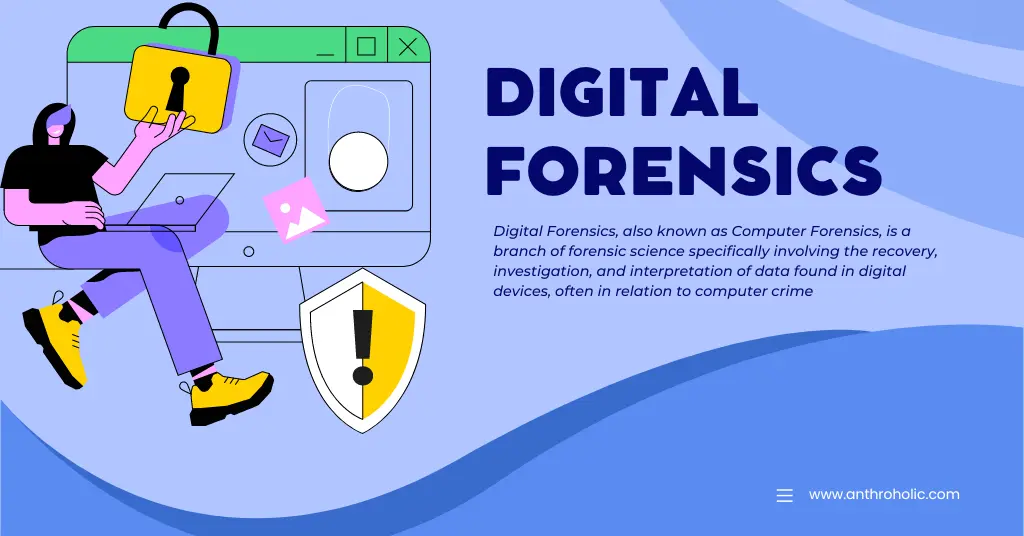AI Answer Evaluation Platform Live Now. Try Free Answer Evaluation Now
Digital Forensics
The advent of the digital age has brought countless benefits, but with it, numerous challenges in maintaining security, integrity, and law enforcement in the cyber realm. At the intersection of technology and justice, there lies an intriguing and dynamic field – Digital Forensics.

What is Digital Forensics?
Digital Forensics, also known as Computer Forensics, is a branch of forensic science specifically involving the recovery, investigation, and interpretation of data found in digital devices, often in relation to computer crime [1]. This can encompass any digital device, ranging from computers and smartphones to digital networks and cloud storage platforms.
The Importance of Digital Forensics
Today’s world is increasingly digital, and therefore, so too is crime. Cybercriminals are becoming more sophisticated, leveraging advanced techniques to commit fraud, theft, and other criminal activities. Digital Forensics plays a vital role in:
- Crime Detection: Forensic experts can trace digital footprints left by perpetrators, thereby revealing criminal activities.
- Evidence Collection: Recovered digital data can provide solid evidence for legal proceedings, increasing the likelihood of convicting criminals.
- Cybersecurity Enhancement: The learnings from forensic investigations can lead to improved security measures, thus preventing future attacks.
The Digital Forensics Process
Digital Forensics involves a systematic, four-step process, outlined in the table below:
| Step | Description |
|---|---|
| 1. Collection | This step involves the identification, labeling, recording, and acquisition of data from the potential sources of relevant information. |
| 2. Examination | A detailed and methodical analysis of the data, using specialized tools and techniques to identify potential evidence. |
| 3. Analysis | The interpretation of the discovered data, evaluating its significance and reliability in relation to the case. |
| 4. Reporting | Documentation of the entire process, findings, and conclusions, providing a clear and concise report that can be used in court proceedings [2]. |
Tools Used in Digital Forensics
Digital Forensics involves the use of specialized tools to recover and analyze digital data. Some commonly used tools include:
- The Sleuth Kit (TSK): An open-source digital forensics toolkit used for analyzing volume and file system data [3].
- Autopsy: A graphical interface to the command-line digital forensics tools in The Sleuth Kit.
- EnCase: A widely used commercial tool that helps in data recovery from various types of digital media.
- Wireshark: A network protocol analyzer used for network troubleshooting, analysis, and forensics.
Challenges in Digital Forensics
Despite its effectiveness, digital forensics faces several challenges, including:
- Volume of Data: The sheer amount of data stored on digital devices can make the process of sifting through it for evidence time-consuming and complex.
- Encryption: Cybercriminals often use encryption to conceal their activities, making data recovery difficult.
- Rapid Technological Change: As technology evolves, so do the methods of cybercrime. Forensic experts must constantly update their knowledge and skills to keep up [4].
Emerging Trends in Digital Forensics
As technology continues to advance, new trends are shaping the field of digital forensics:
- Cloud Forensics: With the widespread adoption of cloud storage and services, cybercrime has also moved to the cloud. This has resulted in the development of cloud forensics, which focuses on tracking and obtaining digital evidence from cloud environments [5].
- Internet of Things (IoT) Forensics: The rapid proliferation of IoT devices, from smart speakers to connected refrigerators, has introduced a new arena for potential cybercrime. IoT forensics involves examining these devices and their associated data for potential evidence [6].
- Artificial Intelligence (AI) in Forensics: AI and machine learning are being utilized to automate and enhance various stages of the digital forensic process, from data acquisition to analysis, helping to overcome the challenge posed by the volume of digital data [7].
Case Studies: Digital Forensics in Action
- Case of Gary McKinnon: Known as the biggest military computer hack of all time, British hacker Gary McKinnon broke into 97 U.S. military and NASA computers over a 13-month period. Through a digital forensic investigation, his activities were traced back to him, demonstrating the ability of digital forensics to track down even highly skilled hackers [8].
- The BTK Serial Killer: Serial killer Dennis Rader, known as BTK, eluded capture for over 30 years. However, it was a floppy disk sent to the police that led to his arrest. Digital forensic investigators were able to extract metadata from the disk that linked it to Rader’s church, highlighting the ability of digital forensics to extract valuable evidence even from seemingly innocuous sources [9].
Career Opportunities in Digital Forensics
With the increasing importance of digital forensics, numerous career opportunities are available in the field. Some potential job titles include:
- Digital Forensics Analyst
- Cybersecurity Analyst
- Incident Response Analyst
- Forensic Computer Investigator
- Information Security Analyst
According to the U.S. Bureau of Labor Statistics, the demand for these roles is projected to grow 31% from 2019 to 2029, much faster than the average for all occupations [10].
Conclusion
As we navigate through the digital era, the importance of digital forensics cannot be overstated. It’s a dynamic field that requires continuous learning and adaptation to new technological advances. As cybercriminals evolve, so must our defenses, and digital forensics is a critical component of that defense strategy.
References
[1] Casey, E. (2011). Digital evidence and computer crime: Forensic science, computers, and the internet. Academic Press.
[2] Carrier, B. (2006). File system forensic analysis. Addison-Wesley.
[3] Garfinkel, S. (2007). Carving contiguous and fragmented files with fast object validation. Digital Investigation.
[4] Casey, E., & Stellatos, G. J. (2008). The impact of full disk encryption on digital forensics. ACM SIGOPS Operating Systems Review, 42(3), 93-98.
[5] Ruan, K., Carthy, J., Kechadi, T., & Crosbie, M. (2011). Cloud forensics. In IFIP International Conference on Digital Forensics (pp. 35-46).
[6] Zeadally, S., Badra, M., & Merabti, M. (2013). Digital forensics and incident response in the Internet of Things. Security and Communication Networks, 6(9), 1101-1114.
[7] Pan, L., & Batten, L. (2011). Application of machine learning to short-term predictions for digital forensic readiness. Journal of Network and Computer Applications, 34(5), 1557-1565.
[8] Hruska, J. (2016). The hacker who cracked 4 NASA computers and caused $700K in damages may never be extradited. ExtremeTech.
[9] Ramsland, K. (2013). Inside the Minds of Serial Killers. Psychology Today.
[10] U.S. Bureau of Labor Statistics. (2020). Information Security Analysts : Occupational Outlook Handbook: : U.S. Bureau of Labor Statistics. Retrieved from https://www.bls.gov/ooh/computer-and-information-technology/information-security-analysts.htm.




